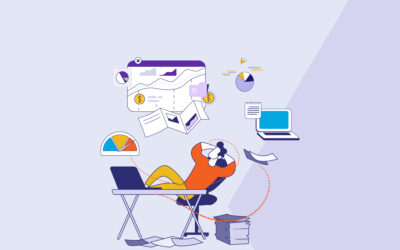A recent LIMRA survey found plenty of enthusiasm for digital transformation among benefits insurers, especially about improving customer experiences.
Which sounds great, right?
Unfortunately, the adoption of technologies to improve claims — the most customer-facing part of insurance — doesn’t quite match the level of interest carriers have expressed about going digital.
The reason?
The LIMRA report cited difficulties with legacy core systems as one of the key roadblocks to further innovation. Old core systems caused reporting challenges for 66% of survey respondents. Other challenges included unconnected internal platforms, a lack of fluidity between systems for customer data, and poor API compatibility. (Legacy systems are now ghosts of their former selves, but the trouble they cause juuuuust won’t go away.)
In this post, we’ll see how two leading benefits insurers are using event-driven architecture in their core platforms to manage complex workplace benefits claims — making life easier for member, customer, and carrier alike. (*cough* We’ll see how they saw remarkable success through their no-holds-barred embrace of digital transformation and innovative coretech from EIS. *cough*)
Streamlining Claims With Event-Based Processing
Consider how many workplace group members have multiple coverages beyond their health insurance. This is a good thing: Today’s employees want a wide range of benefit options so they can personalize insurance based on their life’s needs. But if employers provide this coverage via multiple carriers, employees often have a convoluted nightmare on their hands just getting in touch with each insurer handling each policy.
Even if one carrier provides all or most benefits, it can still be hard for customers to navigate the processes necessary to file claims for an incident (say, a bone break) that applies to multiple coverage types (hospital indemnity, short-term disability insurance, and more, depending on policy terms). It’s guaranteed to be hard if the insurer uses a legacy or modern legacy core system that doesn’t have event-driven architecture.
Monolithic Architecture = Horrific Claims-Filing
Older core systems’ monolithic architectures often mean data for different types of coverage is siloed in a policy-centric setup, rather than being directly tied to employees’ member profiles through airtight data integration. Legacy systems also don’t process data in real time (because they can’t).
This slows down claims processing for an employee with just one coverage type. But when multiple benefits and claims are involved, it’s sluggish enough to be excruciating. That’s bound to frustrate anyone, especially in the fraught times after an injury or serious illness. If situations like this become common enough and generate significant complaints, it’ll frustrate employers. Then they might start thinking about taking their business elsewhere the next time renewal comes around.
One Case = Multiple Coverages; Only One Claim (No More Scary Claims Situations)
With event-based claims handling, a claim becomes a case — it encompasses every employee benefit a person has that applies to a given incident.
The moment the affected individual files their initial claim for one insurance type, it triggers filings for all other relevant protection.
For example, a short-term disability claim and FMLA filing will automatically be filed after a primary health insurance or accident claim stemming from a broken leg, if a broken leg affects the employee’s job. The employee doesn’t have to file more than once or make an endless string of phone calls. Meanwhile, the employer and insurer have a centralized, real-time view of everything that’s going on with the employee’s case, so they’re never caught off-guard no matter how complex the issue becomes.
Event-Driven Claims Success Stories From Two Ambitious Insurers
In an August webinar hosted by LIMRA, two EIS customers — Wellfleet Insurance Company and Pacific Life — discussed our coretech’s benefits, including the advantages of event-based claims.
Wellfleet’s EIS-powered benefits administration platform, Lighthouse, enables them to customize plans and product development, make quick updates, and keep the user experience consistent across multiple distribution channels. It also galvanizes the insurer’s claims processing.
Erik Gray, Wellfleet’s Head of Enrollment Experience, explained Lighthouse’s claims effectiveness through a hypothetical example of an employee with a broken arm:
“With a claims system that has event-driven architecture, all the information for that employee is all in one place,” Gray said. “Say that we received their initial accident claim but then notice they have additional coverage with us, like hospital indemnity, and they spent time in the hospital. We handle that as a single workflow and handle the processing, assessment, and payout as one claims case. We don’t have to send them a reminder about their other coverage, and we will make payment for any other applicable coverages the member has available.”
Similarly, Pacific Life’s digitally native setup enabled innovation at breakneck speed, accelerating product development cycles and improving enrollment onboarding through full digitization. According to SVP and Head of Employee Benefits Division Erich Sternberg, their platform also allowed them to create a truly customer-centric claims experience for group members:
“We designed the claims interface intuitively, so based on the answers to a few questions from the claimant, we’ll know they had an accident, went to the hospital, missed work, and so on,” Sternberg said. “From there, we can manage the whole process in one streamlined fashion, so the customer doesn’t need to make multiple phone calls and go through multiple interactions.”
How EIS Makes it Happen
Because EIS coretech enables the sort of seamless integration and data fluidity that’s impossible with outdated legacy systems, the claims lifecycle can be an efficient, end-to-end workflow. The employee group members are the main “records” around which everything revolves, rather than the policies associated with their benefits.
With CustomerCore™ (the heart of EIS Suite, alongside EIS Platform), carriers have a unified, comprehensive view of each employer-customer that covers every single interaction across the life of the client, including the cases of specific employees. Also, if the employer has medical coverage from a different carrier, the benefits carrier can connect with that insurer (provided there’s approval from all parties involved) using the open APIs that come with EIS Suite. This means the event-based automated claims workflow still functions even when one carrier doesn’t provide all coverage, because the benefits insurer gets alerted when a medical claim is filed.
Ready to Streamline Claims and Satisfy More Customers?
Improving and simplifying the claims experience is one of the best ways workplace benefits insurers can pursue the goal of increased customer satisfaction. EIS Suite gives carriers the architectural foundation necessary to make claims processing as painless as possible.
To learn more about event-based claims (and EIS in general) from two of our most digitally forward customers, check out the full LIMRA webinar.
When you’re ready, book a call to talk to an EIS representative to start planning how our event-driven core system can revolutionize your claims processes for the better.





